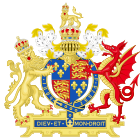Putting away of Books and Images Act 1549
| Act of Parliament | |
 | |
| Long title | An Acte for the abolishing and putting away of dives Bookes and Images. |
|---|---|
| Citation | 3 & 4 Edw. 6. c. 10 |
| Dates | |
| Royal assent | 1 February 1550 |
| Repealed | 15 December 1926 |
| Other legislation | |
| Amended by | Statute Law Revision Act 1888 |
| Repealed by | Roman Catholic Relief Act 1926 |
Status: Repealed | |

The Putting away of Books and Images Act 1549 (3 & 4 Edw. 6. c. 10) was an Act of the Parliament of England.[4]
The preamble of the Act recites:
Wheare the Kinges most Excellent Majestie hathe of late setforthe and established by auctoritie of Parliament an unyforme quyett and godlye ordre of common and open Prayer, in a Booke intituled, The Booke of Common Prayer and Admynistracion of the Sacramentes and other Rytes and Ceremonyes of the Churche after the Churche of England, to be used and observed in the saide Churche of Inglande, agreable to thordre of the prymative Churche, moche more comformable unto his lovinge Subjectes then other diversitye of service as heretofore of longe tyme hathe bene used, beinge in the saide Booke ordeyned nothing to be redd but the verie pure worde of God, or whiche is evidentlye grounded upon the same, &c.[5]
It then proceeds to order the abolishing of all other religious books, as they tend to superstition and idolatry; and commands all persons to deface and destroy images of all kinds that were erected for religious worship, under a penalty for any to prevent the same.
The act concludes, however, with a clause emphasising that its provisions do not extend to the effigies on tomb monuments:
Provyded alwayes, That this Acte, or any thing therin conteyned shall not extende to any Image or Picture sette or graven upon anye Tombe in any Churche Chappell or Churche Yarde, onelye for a Monument of any Kinge Prince Nobleman or other dead person, whiche hath not bene commonly reputed and taken for a Saincte.[5]
It also stipulates that the people might still keep the primers set forth by the late king Henry VIII provided they erase the sentences of invocation, and names of popish saints.
The act was repealed by Mary I, but James I re-established it.[6]
See also
[edit]References
[edit]- ^ Aston, Margaret (1993), The King's Bedpost: Reformation and Iconography in a Tudor Group Portrait, Cambridge: Cambridge University Press, ISBN 978-0-521-48457-2.
- ^ Loach, Jennifer (1999), Bernard, George; Williams, Penry (eds.), Edward VI, New Haven, CT: Yale University Press, p. 187, ISBN 978-0-300-07992-0
- ^ Hearn, Karen (1995), Dynasties: Painting in Tudor and Jacobean England 1530–1630, New York: Rizzoli, pp. 75–76, ISBN 978-0-8478-1940-9
- ^ No Sacred Place: Bad Faith, Lies, and Illusions. Ivan Hugh Walters. 2011
- ^ a b The Statutes of the Realm. Vol. 4. London: Record Commission. 1819. pp. 110–111 .
- ^ Timperley, C. H. (1839). A Dictionary of Printers and Printing. London: H. Johnson.
